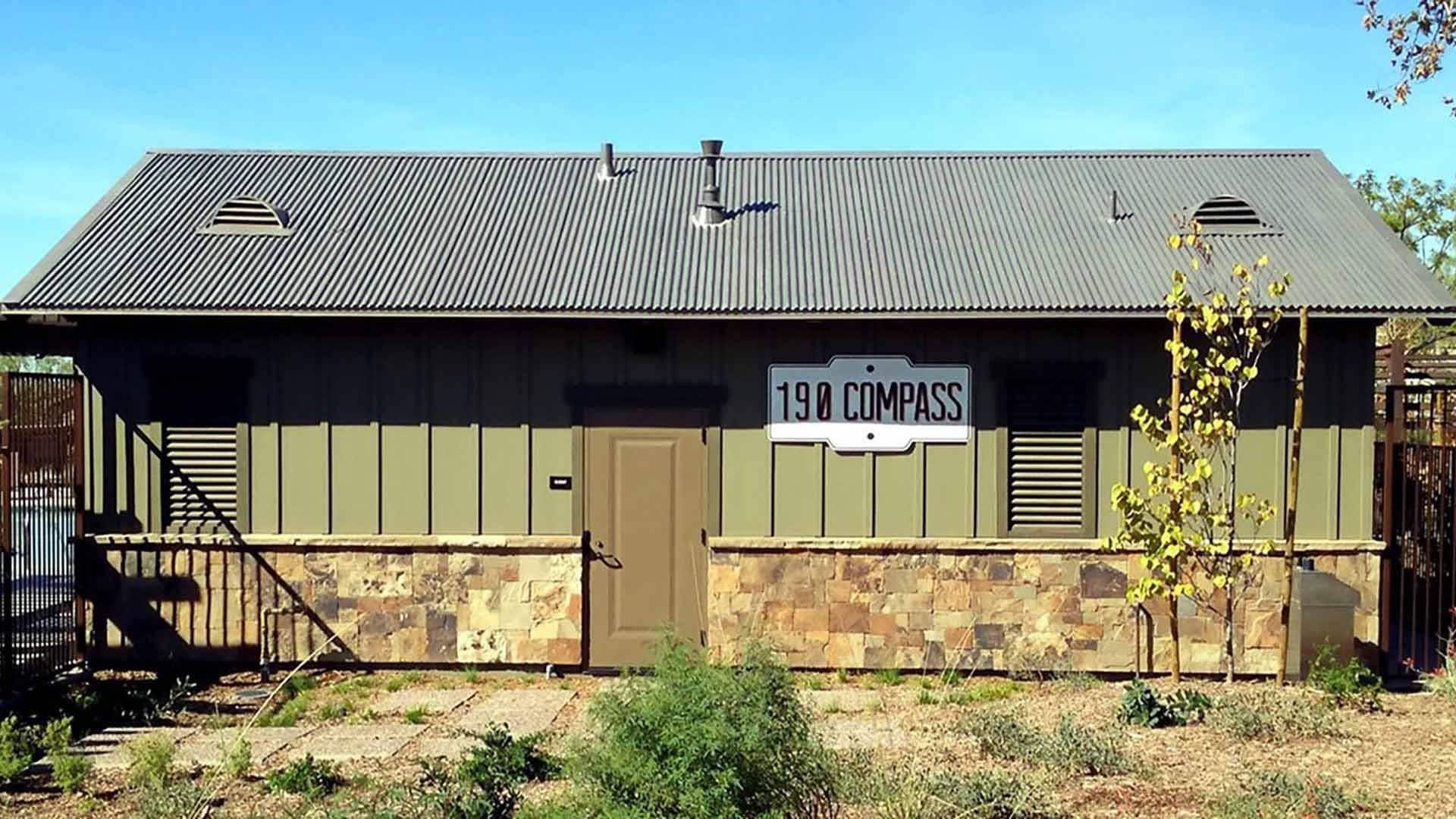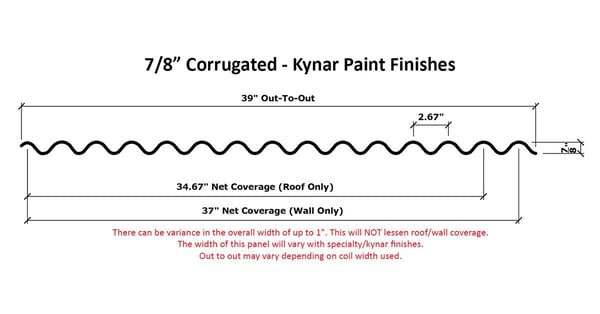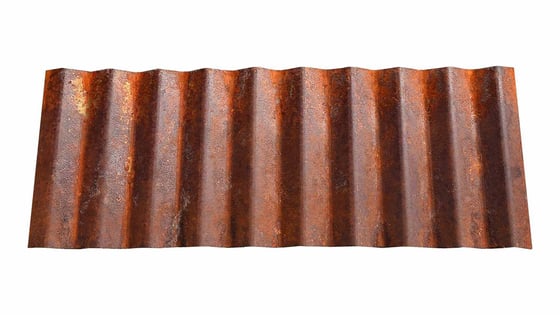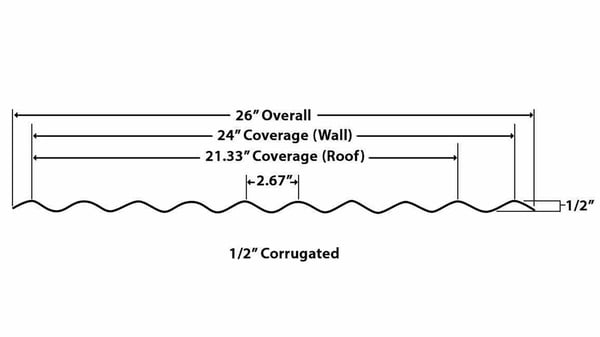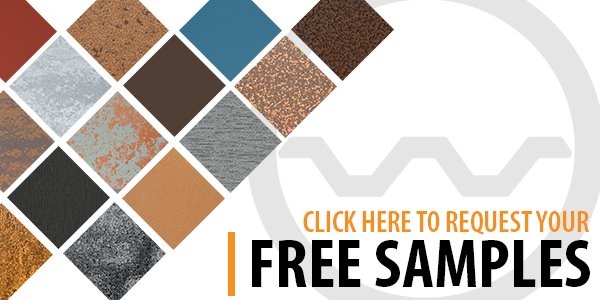What is Corrugated Metal Roofing? A Detailed Definition, Panel Types & Uses
What Is Corrugated Metal Roofing?
Corrugated metal roofing is a metal sheet that is roll formed into a metal panels. These panels are than attached to the roof with screws. Corrugated metal is an exposed fastener panel, meaning that each fastener is visible on the panel's surface.
The traditional shape of corrugated sheet metal is round and wavy. It is low cost, light weight, durable, energy efficient, long lasting, and easy to install. Corrugated metal roofing is an excellent alternative to asphalt shingles or clay tile roofs. The durability of corrugated panels makes them a fit for both commercial and residential applications when used for metal roofing and metal siding projects. They are even used in other areas of the home including the ceiling, wainscoting and as fencing.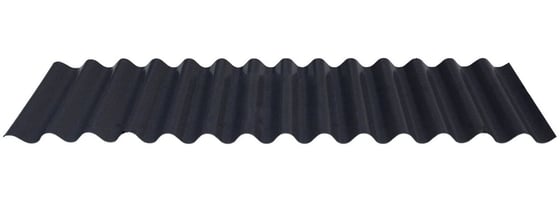 ⅞” Corrugated Metal Roofing Panel in Dark Bronze
⅞” Corrugated Metal Roofing Panel in Dark Bronze
The term corrugated metal roofing is a bit tricky. People in the roofing industry will only refer to an “ S “ shaped wavy panel as corrugated. In simple terms it is anything round and wavy and NOT square or boxy. However, the term corrugated could mean any type of metal that is formed into grooves and ridges. It could literally mean any type of metal roofing including the more square and boxy looking panels.
Sheets of metal are made stronger by corrugating, or folding the metal to make grooves and ridges. Steel already has a higher tensile strength than wood, meaning it’s more resistant to breaking under tension. The corrugation process further increases the tensile strength of steel. This means that a light gauge metal like aluminum, copper, or steel, which may otherwise be flimsy, can be made into a strong panel. It creates a panel with high strength-to-weight ratios that can hold up to years of punishment in all kinds of weather.
Corrugated metal roofing is made from steel coils. Typically, the steel will have an underlying layer applied that is normally galvanized or galvalume®. The material is either left unpainted or sent to a painter. These coils are then shipped to a metal roofing supplier and they will corrugate the panels.
How Is Corrugated Metal Made?
The corrugation process is accomplished by roll forming. This means that the sheet metal is pulled off of huge round metal coils and than it passes through rolling dies that form the panel into a corrugated sheet metal. After the corrugated metal sheets pass through all of the rollers, it is sheared off at the correct panel length.
Corrugated steel originated in the 1820’s and was invented by Henry Robinson Palmer. He worked at the London Dock Company and designed the corrugated steel panel so that workers with minimal construction skills could install it quickly. It became popular immediately as it was prefabricated and inexpensive.
Types of Corrugated Metal Roofing
Corrugated metal is a generic term that means any type of sheet steel strengthened for use in construction by having a series of alternating grooves and ridges forced into it. Technically, this could mean any metal roofing or wall panel. However, people that are in the industry define a corrugated metal panel as a metal roofing or siding panel that has S type wavy and round corrugations.
There are three basic types of corrugated panels: ⅞” Corrugated, ½” Corrugated, and everything else including ribbed metal roofing panels.
⅞” Corrugated Roofing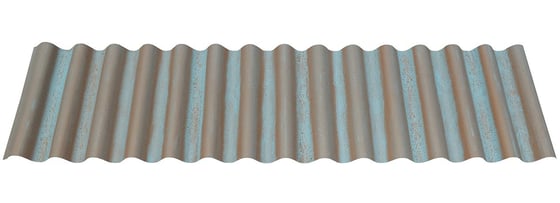 ⅞” Corrugated in Streaked Copper
⅞” Corrugated in Streaked Copper
⅞” Corrugated roofing is the most popular corrugated metal roofing panel. The deep corrugations create a shadow like effect and therefore this is the nicest looking of the corrugated panels. In addition, it is the strongest and cheapest wavy corrugated panel. The center to center of the corrugations are 2.67” and the height is ⅞”. This panel cannot be used on a flat roof. The required roofing slope is a minimum of 3” in 12”.
.jpeg?width=400&name=What%20is%20Corrugated%20Metal%20Roofing%3F%20(Including%20Types%20Of%20Corrugated%20Metal).jpeg)
Coverage And Side Lap For 7/8” Corrugated Metal Roofing
- Overall Width: 39”
- You will have multiple panels on your roof and each roofing panel is typically 39” or 37” wide depending upon the manufacturer. The overall width of the panel shown above is 39”
- Roof coverage of 34.67”
- A 39” panel will provide 34.67” of roof coverage. If used in a roofing application the panel must be lapped back two corrugations. The diagram above shows the roof coverage starting at the left edge of the panel and ending two corrugations from the far right edge. This means that after you install your first panel the next panel will have to be lapped back two corrugations. The 39” wide panel only yielded 34.67”.
- Overall Width: 26”
- You will have multiple panels on your roof and each roofing panel is typically 26” wide. The overall width of the panel shown above is 26”
- Roof coverage of 21.33”
- A 26” panel will provide 21.33” of roof coverage. If used in a roofing application the panel must be lapped back two corrugations. The diagram above shows the roof coverage starting at the left edge of the panel and ending two corrugations from the far right edge. This means that after you install your first panel the next panel will have to be lapped back two corrugations. The 26” wide panel only yielded 21.33”.
You lose coverage every time that you do this. This means that you will have to buy more square footage than the size of your roof or wall.
What You Need To Know About Buying ⅞” Corrugated Metal Roofing
In a roofing application you have to purchase 10% to 12% additional corrugated roofing and in a metal siding application it will be about 6% additional material.
When you purchase corrugated metal roofing your pricing is by the square foot which is calculated by multiplying the width of the sheet by the length of the panel.
For example, if you purchased a 39” wide panel that is ten feet in length it would be 32.5 square feet. You will pay for 32.5 square feet of material, but the roof coverage will only be about 29 square feet. Essentially, you need to purchase twelve percent more roofing panels.
½” Corrugated Roofing
1/2” Corrugated is the old fashioned roofing that you see at old western and ghost towns. This is the original corrugated that has been around for years. However, it is not as common as it used to be because 7/8“ corrugated is a stronger panel that cost less money.
The center to center of the corrugations are 2.67” and the height is 1/2”. The required roofing slope is a minimum of 3” in 12”. This panel is typically 26” wide depending upon the manufacturer. Keep in mind that you pay for the full width of the panel and NOT the coverage.
Coverage and Side Lap for 1/2” Corrugated Metal Roofing
You lose coverage every time that you do this. This means that you will have to buy more square footage than the size of your roof or wall.
What You Need To Know About Buying ½” Corrugated Metal Roofing
In a roofing application you have to purchase 23% additional corrugated metal roofing and in a wall application it will be about 10% additional material.
When you purchase corrugated roofing the pricing is by the square foot which is calculated by multiplying the width of the sheet by the length of the panel.
For example, if you purchased a 26” wide panel that is ten feet in length it would be 21.67 square feet. You will pay for 21.67 square feet of material, but the roof coverage will only be about 17.77 square feet. Essentially, you need to purchase twenty three percent more roofing panels.
Ribbed Roofing And Other Corrugated Panels
This would cover anything that is NOT wavy. These are your boxy and square metal roofing profiles. We will not go into each of these, but an example of the most common type would be known as R Panel or PBR Panel.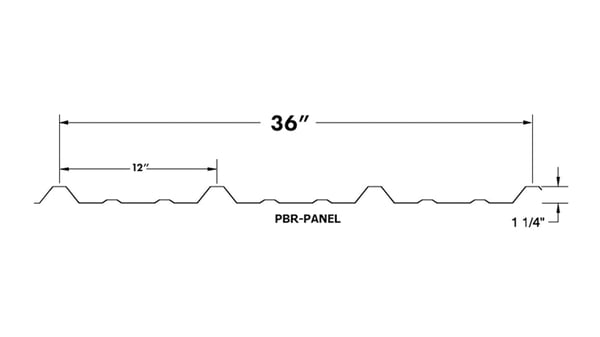
Learn More About Corrugated Metal Roofing
If you are in the process of choosing a metal roof for your dream house the first step is determining the panel type. There are a lot of factors that will go into this, but learning about corrugated is an excellent starting point. The next step is to learn about the finishes.

